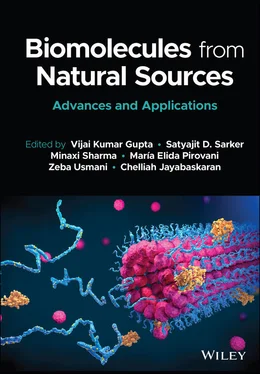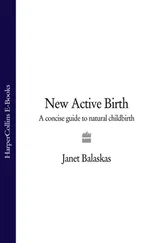Biomolecules from Natural Sources
Здесь есть возможность читать онлайн «Biomolecules from Natural Sources» — ознакомительный отрывок электронной книги совершенно бесплатно, а после прочтения отрывка купить полную версию. В некоторых случаях можно слушать аудио, скачать через торрент в формате fb2 и присутствует краткое содержание. Жанр: unrecognised, на английском языке. Описание произведения, (предисловие) а так же отзывы посетителей доступны на портале библиотеки ЛибКат.
- Название:Biomolecules from Natural Sources
- Автор:
- Жанр:
- Год:неизвестен
- ISBN:нет данных
- Рейтинг книги:5 / 5. Голосов: 1
-
Избранное:Добавить в избранное
- Отзывы:
-
Ваша оценка:
- 100
- 1
- 2
- 3
- 4
- 5
Biomolecules from Natural Sources: краткое содержание, описание и аннотация
Предлагаем к чтению аннотацию, описание, краткое содержание или предисловие (зависит от того, что написал сам автор книги «Biomolecules from Natural Sources»). Если вы не нашли необходимую информацию о книге — напишите в комментариях, мы постараемся отыскать её.
An up-to-date exploration of new and novel biomolecules Biomolecules from Natural Sources: Advances and Applications,
Biomolecules from Natural Sources: Advances and Applications
Natural Sources: Advances and Applications
Biomolecules from Natural Sources — читать онлайн ознакомительный отрывок
Ниже представлен текст книги, разбитый по страницам. Система сохранения места последней прочитанной страницы, позволяет с удобством читать онлайн бесплатно книгу «Biomolecules from Natural Sources», без необходимости каждый раз заново искать на чём Вы остановились. Поставьте закладку, и сможете в любой момент перейти на страницу, на которой закончили чтение.
Интервал:
Закладка:
53 Kundu, D., Hazra, C., and Chaudhari, A. (2016b). Bioremediation potential of Rhodococcus pyridinivorans NT2 in nitrotoluene-contaminated soils: the effectiveness of natural attenuation, biostimulation and bioaugmentation approaches. Soil and Sediment Contamination: An International Journal 25: 637–651.
54 Kundu, D., Hazra, C., Dandi, N., and Chaudhari, A. (2013). Biodegradation of 4- nitrotoluene with biosurfactant production by Rhodococcus pyridinivorans NT2: metabolic pathway, cell surface properties and toxicological characterization. Biodegradation 24: 775–793.
55 Kuyukina, M.S. and Ivshina, I.B. (2010). Rhodococcus biosurfactants: biosynthesis, properties, and potential applications. In: Biology of Rhodococcus (ed. H. Alvarez), Microbiology Monographs, vol 16, 291–313. Springer.
56 Kuyukina, M.S. and Ivshina, I.B. (2019). Production of trehalolipid biosurfactants by Rhodococcus. In: Biology of Rhodococcus (ed. H. Alvarez), Microbiology Monographs, vol 16, 271–298. Cham: Springer.
57 Kuyukina, M.S., Ivshina, I.B., Baeva, T.A., Kochina, O.A., Gein, S.V., and Chereshnev, V.A. (2015). Trehalolipid biosurfactants from nonpathogenic Rhodococcus actinobacteria with diverse immunomodulatory activities. New Biotechnology 25; 32 (6): 559–568.
58 Kuyukina, M.S., Ivshina, I.B., Gein, S.V., Baeva, T.A., and Chereshnev, V.A. (2007). In vitro immunomodalating acitivity of biosurfactant glycolipid complex from Rhodococcus rubber. Bulletin of Experimental Biology and Medicine 144 (3): 326–330.
59 Kuyukina, M.S., Ivshina, I.B., Korshunova, I.O., Stukova, G.I., and Krivoruchko, A.V. (2016). Diverse effects of a biosurfactant from Rhodococcus ruber IEGM 231 on the adhesion of resting and growing bacteria to polystyrene. AMB Express 6 (14): 1–12.
60 Kuyukina, M.S., Ivshina, I.B., Philp, J.C., Christofi, N., Dunbar, S.A., and Ritchkova, M.I. (2001). Recovery of Rhodococcus biosurfactants using methyl tertiary-butyl ether extraction. Journal of Microbiological Methods 46: 149–156.
61 Kuyukina, M.S., Varushkina, A.M., and Ivshina, I.B. (2020). Effects of electroporation on antibiotic susceptibility and adhesive activity to n-hexadecane in Rhodococcus ruber IEGM 231. Applied Biochemistry and Microbiology 56: 729–735.
62 Lang, S. and Philp, J.C. (1998). Surface-active lipids in rhodococci. Antonie van Leeuwenhoek 74 (1/3): 59–70.
63 Lin, S.-C., Lin, K.-G., and Lin, Y.M. (1998). Enhanced biosurfactant production by a Bacillus licheniformis mutant. Enzyme and Microbial Technology 23: 267–273.
64 Mclaughlin, C.A., Schwartzman, S.M., Horner, B.L. et al. (1980). Regression of tumors in guinea pigs after treatment with synthetic muramyl dipeptides and trehalose dimycolate. Science (80) 208 (4442): 415–416.
65 Makkar, R.S., Cameotra, S.S., and Banat, I.M. (2011). Advances in utilization of renewable substrates for biosurfactant production. AMB Express 1 (1): 1–19.
66 Marqués, A.M., Pinazo, M., Farfana, F.J., Aranda, J.A., Teruel, A., Ortiz, A., Manresa, A., and Espunya, M.J. (2009). The physicochemical properties and chemical composition of trehalose lipids produced by Rhodococcus erythropolis 51T7. Chemistry and Physics of Lipids 158: 110–117.
67 Mata-Sandoval, J.C., Karns, J., and Torrents, A. (1999). High-performance liquid chromatography method for the characterization of rhamnolipid mixtures produced by Pseudomonas aeruginosa UG2 on corn oil. Journal of Chromatography A 864: 211–220.
68 Matsumoto, Y., Cao, E., and Ueoka, R. (2013). Novel liposomes composed of dimyristoylphosphatidylcholine and trehalose surfactants inhibit the growth of tumor cells along with apoptosis. Biological & Pharmaceutical Bulletin 36 (8): 1258–1262.
69 Matsumoto, Y., Kuwabara, K., Ichihara, H., and Kuwano, M. (2016). Therapeutic effects of trehalose liposomes against lymphoblastic leukemia leading to apoptosis in vitro and in vivo. Bioorganic & Medicinal Chemistry Letters 15, 26 (2): 301–305.
70 Mnif, I., Ghribi, D. (2015). Microbial derived surface active compounds: properties and screening concept. World Journal of Microbiology and Biotechnology 31 (7): 1001–1020.
71 Mnif, I. and Ghribia, D. (2016). Glycolipid biosurfactants: main properties and potential applications in agriculture and food industry. Journal of the Science of Food and Agriculture 96 (13): 4310–4320.
72 Morikawa, M., Hirata, Y., and Imanaka, T. (2000). A study on the structure-function relationship of lipopeptide biosurfactants. Biochimica et Biophysica Acta 1488: 211–218.
73 Mujumdar, S., Joshi, P., and Karve, N. (2019). Production, characterization, and applications of bioemulsifiers (BE) and biosurfactants (BS) produced by Acinetobacter spp.: a review. Journal of Basic Microbiology 59 (3): 277–287.
74 Mukherjee, S., Das, P., and Sen, R. (2006). Towards commercial production of microbial surfactants. Trends in Biotechnology 24 (11): 509–514.
75 Mulligan, C.N., Cooper, D.G., and Neufeld, R.J. (1984). Selection of microbes producing biosurfactants in media without hydrocarbons. Journal of Fermentation Technology 62: 311–314.
76 Mutalik, S.R., Vaidya, B.K., Joshi, R.M., Desai, K.M., and Nene, S.N. (2008). Use of response surface optimization for the production of biosurfactant from Rhodococcus spp. MTCC 2574. Bioresource Technology 99: 1875–7880.
77 Natsuhara, Y., Oka, S., Kaneda, K., and Yano, I. (1990). Parallel antitumor, granuloma forming and tumor-necrosis-factor-priming activities of mycoloyl glycolipids from Nocardia rubra that differ in carbohydrate moiety: structure–activity relationships. Cancer Immunology, Immunotherapy 31: 99–106.
78 Oliveira, M.R., Magri, A., Baldo, C., Camilios-Neto, D., Minucelli, T., and Celligo, M.A.P.C. (2015). Review: sophorolipids a promising biosurfactant and its applications. International Journal of Advanced Biotechnology and Research 6 (2): 161–174.
79 Pacheco, G.J., Ciapina, E.M.P., Gomes, E.B., and Pereira-Junior, N. (2010). Biosurfactant production by Rhodococcus erythropolis and its application to oil removal. Brazilian Journal of Microbiology 41 (3): 685–693.
80 Patil, H.I. and Pratap, A.P. (2018). Production and quantitative analysis of trehalose lipid biosurfactants using high-performance liquid chromatography. Journal of Surfactants and Detergents 21 (4): 553–564.
81 Paulino, B.N., Pessôa, M.G., Mano, M.C.R., Molina, G., Neri-Numa, I.A., and Pastore, G.M. (2016). Current status in biotechnological production and applications of glycolipid biosurfactants. Applied Microbiology and Biotechnology 100: 10265–10293.
82 Philp, J.C., Kuyukina, M.S., Ivshina, I.B., Dunbar, S.A., Christofi, N., Lang, S., and Wray, V. (2002). Alkanotropic Rhodococcus ruber as a biosurfactant producer. Applied Microbiology and Biotechnology 59: 318–324.
83 Pinzon, N. and Ju, L.K. (2009). Improved detection of rhamnolipid production using agar plates containing Methylene blue and cetyltrimethyl ammonium bromide. Biotechnology Letters 31: 1583–1588.
84 Pinzon, N.M., Zhang, Q., Koganti, S., and Ju, L.K. (2009). Advances in bioprocess development of rhamnolipid and sophorolipid production. In: Biobase Surfactants and Detergents—Synthesis, Properties, and Applications (ed. D.G. Hayes, D. Kitamoto, D.K.Y. Solaiman, and R.D. Ashby), 77–105. Urbana, IL: AOCS Press.
85 Ramsay, B., McCarthy, J., Guerra-Santos, L., Kappeli, O., Fiechter, A., and Margaritis, A. (1988). Biosurfactant production and diauxic growth of Rhodococcus aurantiacus when using n -alkanes as the carbon source. Canadian Journal of Microbiology 34 (11): 1209–1212.
86 Ribeiro, I.A., Bronze, M.R., Castro, M.F., and Ribeiro, M.H.L. (2012). Design of selective production of sophorolipids by Rhodotorula bogoriensis through nutritional requirements. Journal of Molecular Recognition 25 (11): 630–640.
Читать дальшеИнтервал:
Закладка:
Похожие книги на «Biomolecules from Natural Sources»
Представляем Вашему вниманию похожие книги на «Biomolecules from Natural Sources» списком для выбора. Мы отобрали схожую по названию и смыслу литературу в надежде предоставить читателям больше вариантов отыскать новые, интересные, ещё непрочитанные произведения.
Обсуждение, отзывы о книге «Biomolecules from Natural Sources» и просто собственные мнения читателей. Оставьте ваши комментарии, напишите, что Вы думаете о произведении, его смысле или главных героях. Укажите что конкретно понравилось, а что нет, и почему Вы так считаете.


![Джеймс Купер - Пионеры, или У истоков Саскуиханны [The Pioneers, or The sources of the Susquehannah]](/books/395797/dzhejms-kuper-pionery-ili-u-istokov-saskuihanny-t-thumb.webp)









